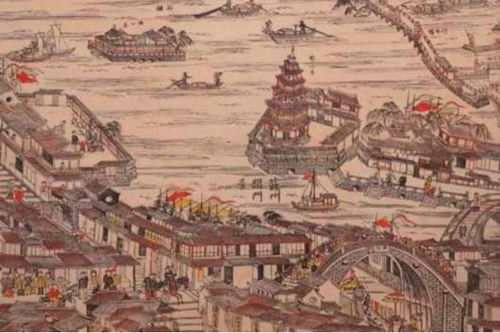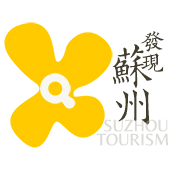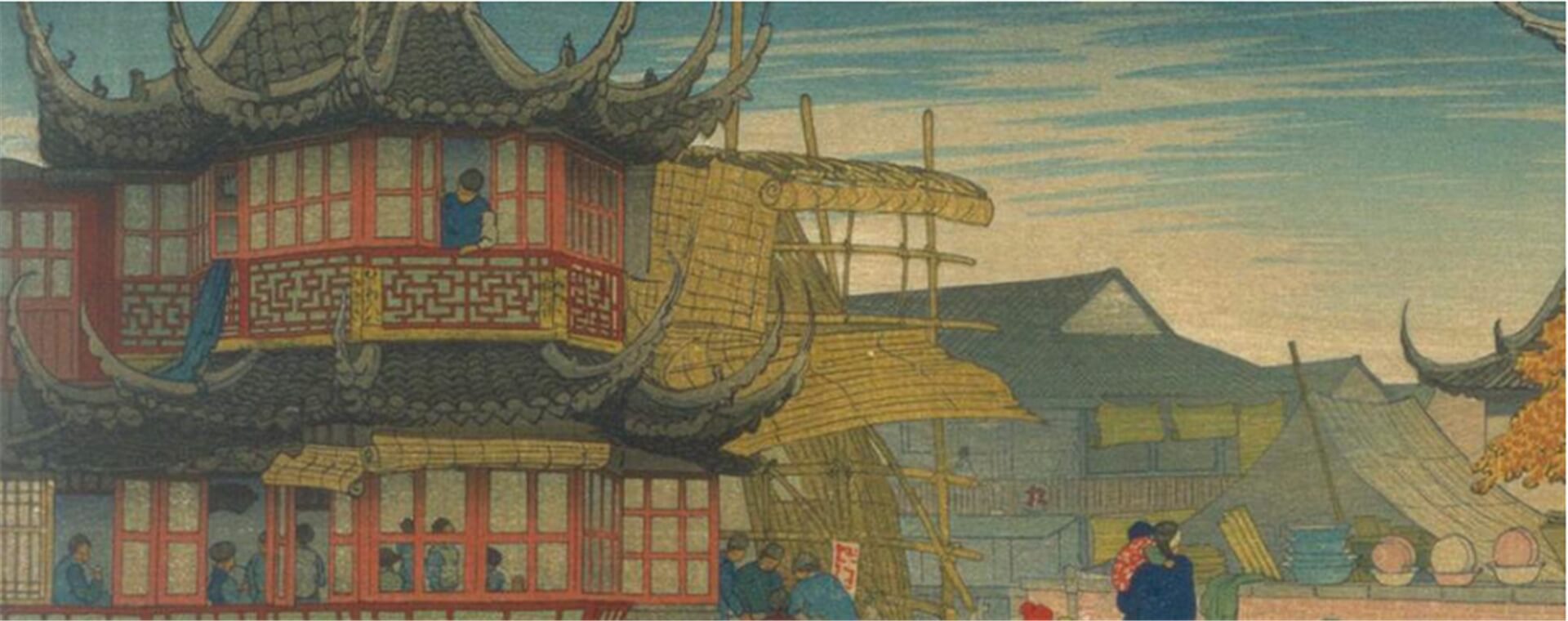More than 3000 years ago, Taibo and Zhongyong, the sons of Gu Gongfu, the leader of the Zhou Dynasty, abdicated to Ji Li, his younger brother. They exiled themselves to Meili on the edge of Taihu Lake from the city of Ho Jing (today’s Xi’an) thousands of miles away. They intermarried with the local people, cut off their hair and established the legendary “Kingdom of Gou Wu”. This is the story of “taiberguo” in Zuozhuan. Ji Li lived up to the expectations of his father and brother. After succeeding to the throne, he promoted Zhou to prosperity. His son, Jichang, King Wen of Zhou, and the exiled Taibo and Zhongyong became the ancestors of Wu.

In 561 BC, the king of Wu died in his dream on his birthday. In order to avoid the edge of Chu, Zhufan, the new king of Wu, decided to move his capital south to Suzhou, which is the beginning of Suzhou as an ancient city. After the death of Zhufan, the state of Wu changed several monarchs. Finally, after a coup, the son of Zhufan took real power and became king, that is, Helu, the king of Wu.

As the saying goes, without Wu Zixu, there would be no Suzhou city. 2500 years ago, it witnessed the drastic change of Wu state from prosperity to decline. According to historical records, when Wu Zixu was entrusted by the king of Wu, he took great pains to come to the land of Wuzhong and “tasted water like heaven and earth”. On the Bank of Taihu Lake, a brand-new capital has been built. It is called “Helu city”, which is the ancient city of Suzhou today. Since then, Suzhou has become one of the most important economic and cultural centers in the south of the Yangtze River.

When Fu Chai, the new king of Wu, defeated the state of Yue and forced Gou Jian to surrender then Wu Zixu’s bad luck came. After repeatedly persuading the king of Wu to kill Gou Jian, Wu Zixu was given a sword by the king of Wu. Before he died, Wu Zixu left his last words, asking his family to dig out his eyes and hang them on the east gate after he died. He wanted to see the Yue army destroy Wu with his own eyes. As Wu Zixu expected, after Wu was destroyed by Yue, “Helu city” quietly watched the protracted struggle for hegemony gradually go away.

After the unification of the six states, Qin Shihuang took today’s Fujian, Zhejiang and southern Jiangsu areas as Kuaiji County, and took Gusu, the ancient city of Wu state, as the governing seat, which was called Wu County. Although Wu County was a county in Qin and Han Dynasties, its territory was as big as Suzhou today. Suzhou City has become what people call the first city in Jiangdong. At the end of the Han Dynasty, all the heroes rose together. Sun CE, the “little overlord”, calmed down Jiangdong and established the foundation of the eastern Wu Dynasty. His young life disappeared in the Wu area, and unfortunately he died of the villain’s assassination. His good brother Zhou Yu also died young after he made immortal achievements in Chibi. Outside the city of Gusu, there are heroic elegy. Sun Quan, the younger brother of sun CE, established the state of Wu under the rule of Jiangdong. Wu County, Danyang county and Wuxing county are called “three Wu” and are the most important regions in the three Wu. A few centuries later, Liu Yong, a famous poet of the Song Dynasty, wrote: “the southeast is prosperous, the capital of Wu, and Qiantang has been prosperous since ancient times.” This is the beginning of the metropolis that makes the gold Lord covet. At the beginning of the 4th century, the Western Jin Dynasty was destroyed, and the Chinese land was divided for nearly 400 years. At that time, there were constant wars in the north, and Suzhou became one of the “three Wu Olympic regions” famous for its wealth. With the southward migration of northern celebrities, a wave of cultural construction climax has begun here. Countless temples, temples, pavilions and pavilions have sprung up, which has laid the tone of simplicity and elegance of this millennium water town, and also brought a different Buddhist mentality to the Wu people.

In the Sui and Tang Dynasties, under the great plan of emperor Yang of the Sui Dynasty, the Beijing Hangzhou Grand Canal connected the Haihe River, the Yellow River, the Huaihe River, the Qiantang River and the Yangtze River. At the same time, the Sui Dynasty abolished Wujun and officially renamed it Suzhou, which is the beginning of Suzhou’s name. Since the Tang Dynasty, with the southward shift of the national economic center, China’s economic center began to take the Yangtze River Basin as the leading role, moving from west to east to Yangzhou, Suzhou, Hangzhou and other places. The frequent cultural exchanges and economic exchanges between the north and the South have greatly stimulated the economic development of Suzhou. Therefore, on this basis, people began to build water conservancy and dredge rivers, and the ancient city of Suzhou gradually formed a regular form of “three horizontal and four straight rivers”.

In the Song and Yuan Dynasties, a large number of cultural personages went all the way south to live here. The cultural and entertainment industry in Suzhou is prosperous. Suzhou has been destroyed and burned many times, but with its solid material base and mature humanistic concept, the ancient city has experienced many vicissitudes and still dominates the south of the Yangtze River. As the saying goes, “Su lake is ripe, the world is full.”. During the Ming and Qing Dynasties, Suzhou’s economy entered its heyday. The prosperous state of foreign exchange and trade has opened up people’s horizons and ideas, and created a relaxed environment for the diversified development of Suzhou’s economy, culture and market life. Suzhou has gradually developed into a national industrial and commercial center and a silk center. During this period, Suzhou was a well deserved elder brother of Jiangsu Province. The governor of Jiangnan in the Ming Dynasty, the governor of Jiangsu in the Qing Dynasty, and the Suzhou weaving department, a special organization for purchasing daily necessities for the royal family, were all in Suzhou. Social life is in an extremely active state, which makes Suzhou people correct the past thought of valuing culture over commerce earlier, and provides a better development environment for the sprouting of capitalism in Suzhou. Poetic Suzhou is infiltrated in this splendid prosperity.

In the late Qing Dynasty, because of the backwardness and corruption of the Qing government, the country was bombarded by the powerful ships. Afterwards, Jiangsu and Zhejiang fell into the tide of “Taiping Heavenly Kingdom Movement”. As an important economic town in the south of the Yangtze River at that time, Suzhou was so rich that the leaders of the Taiping Army coveted it and took it as their own.

Zhongwang mansion of the Taiping Heavenly Kingdom is now the Suzhou Museum. However, Suzhou has always been an important tax area for the imperial court. Therefore, the war inevitably started again in the ancient city of Suzhou. After three years of Taiping Rebellion, Suzhou has become a ruin. As people said at that time, “Huqiu a tower survived, the rest of the earth is Fu.” Suzhou, hit hard, never recovered. On the other hand, the root cause of the decline of Suzhou was the rise of modern Shanghai. Since the opening of Shanghai in 1843, the import and export trade of cotton, silk, tea and other bulk commodities, which was originally limited to Guangzhou, has been rapidly transferred to the new port “Shanghai”.
Shanghai has the advantage of deep-water port which is necessary in the era of navigation, so it is more popular with westerners. Shanghai has gradually developed from a small fishing port to a financial and manufacturing center in China. With the withdrawal of capital and the migration of population, the former “Xiongzhou” in the south of the Yangtze River has become a ruined city full of holes. The prosperity of Suzhou and even the whole Yangtze River Delta is partly inherited by Shanghai. In the past, it was said that “everything in Jiangnan is based on Suzhou”. By the end of the 19th century, it became “Suzhou’s business market is based on Shanghai.”. In history, Shanghai was once known as “little Suzhou”. At this time, Suzhou was called “little Shanghai” in turn. Over time, even the water system of Suzhou developed river, which was amazing to the world at the beginning, has become more and more silted up and seriously polluted. Suzhou, the Pearl of Jiangnan in the past, has been eclipsed.
Suzhou people don’t accept their fate. Although Suzhou has declined, its foundation is still there. Before and after the revolution of 1911, there was a dispute between Suzhou and its surrounding cities. In order to fight for the provincial capital, the largest province in China’s economy at that time became a mess. In 1912, Cheng Dequan, the governor of Jiangsu Province in the late Qing Dynasty, joined the revolution and became the governor of Jiangsu Province. He wavered between Suzhou and Nanjing about choosing the provincial capital. Cheng Dequan ran back and forth, but neither side could please him. He was so angry that he went to Shanghai to “recuperate”. After that, Nanjing became the capital of the Republic of China, and Suzhou became the capital of Jiangsu Province. In 1928, when Jiangsu elected the new provincial capital and the provincial government held a meeting, Zhenjiang got six votes, Yangzhou two votes and Suzhou only one vote. Falling from the top is more painful than climbing the top.
With the coming of the golden age, the people of Suzhou ignited the fire of rejuvenation and recovered the sense of being like the “leading elder brother”. Today, although Suzhou no longer dominates the country in economy, it ranks seventh in the country, following the six major cities of Beijing, Shanghai, Guangzhou and Shenzhen.
It is worth mentioning that among the top 20 ordinary prefecture level cities in 2019, Suzhou ranks the first with a GDP of 1923.58 billion yuan. It is hard to meet any rival among all ordinary prefecture level cities, and it is even more powerful than many provincial capitals, coastal open cities and special economic zones. Suzhou’s GDP in Jiangsu Province has always ranked first without any doubt. Suzhou is also the second largest immigrant city in China after Shenzhen. The number of immigrants has exceeded the local population, and the scale of the city is no less than that of Shanghai and Nanjing. In the context of economic prosperity, Suzhou’s urban landscape has quietly changed. Different from the small bridge and flowing water landscape in the past, Suzhou now pays more attention to the integration of modern height and ancient culture in its architectural style, which is the poetic flavor of the new era.
In the new urban planning, skyscrapers seem to be the new focus of urban construction. The Oriental gate, commonly known as “big autumn pants”, is 301.8 meters high, about six times as high as the French Arc de Triomphe. It is located at the east end of the CBD axis of Suzhou Industrial Park. The tallest building in Suzhou, Suzhou international financial center, a 450 meter skyscraper, has set a new record in Jiangsu Province since its top in 2018, and has become a new landmark on the Bank of Jinji Lake.
In recent years, with the government’s attention and Suzhou people’s awareness of the protection of ancient cultural heritage, Suzhou’s urban water system is gradually getting better. It is reported that Suzhou has more than 20000 rivers, and there will be “River heads” in the future. Suzhou people take water control seriously, and the name of “Oriental Venice” is not in vain.

